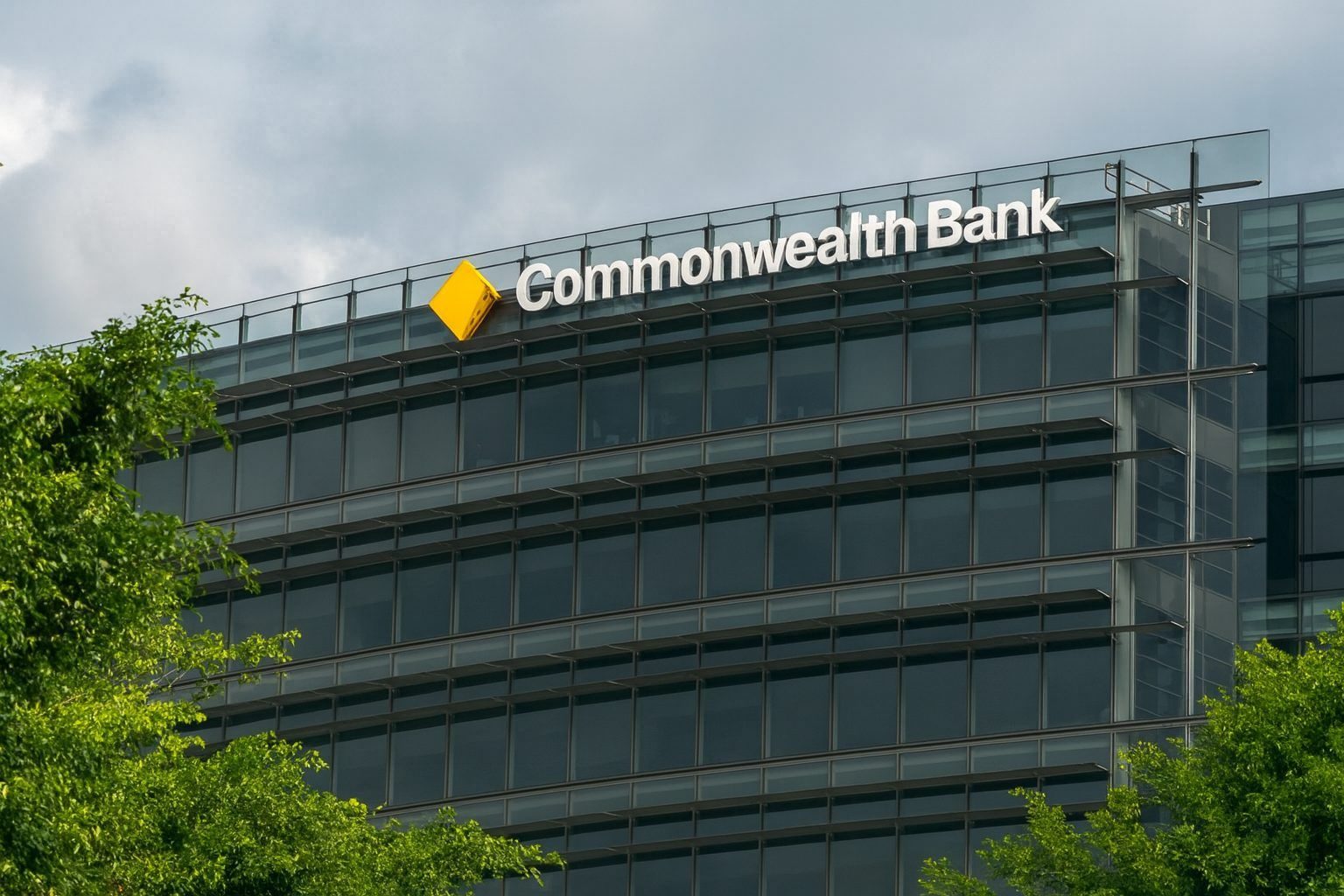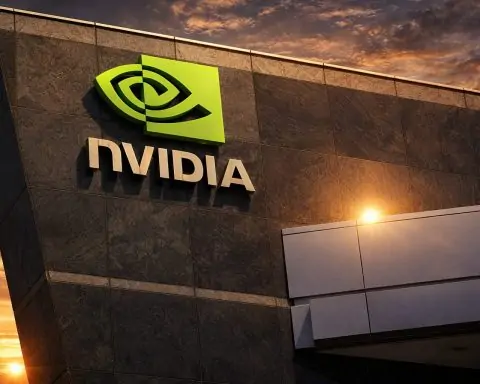Commonwealth Bank of Australia (ASX: CBA) heads into Thursday, 27 November 2025 under a bright but complicated spotlight: the share price is hovering in the mid‑A$150s, regulators are tightening home‑loan rules, inflation has surprised on the upside, and the bank has just unveiled a high‑profile Chief AI Officer.
Below is a rundown of the latest CBA share price data, all key news dated 27 November 2025, and what it could mean for investors following Australia’s biggest bank.
CBA share price snapshot heading into 27 November 2025
At the close of trading on Wednesday, 26 November 2025, Commonwealth Bank of Australia shares finished at A$153.52, up about 0.25% (A$0.38) on the day. The session saw a trading range between A$153.14 and A$154.93, with the stock sitting closer to the lower half of its 52‑week band of A$140.21 to A$192.00. [1]
Key snapshot metrics at that close include: [2]
- Last close: A$153.52
- Day move (26 Nov): +0.25%
- Day’s range: A$153.14 – A$154.93
- 52‑week range: A$140.21 – A$192.00
- Market capitalisation: ~A$256.7 billion
- P/E ratio: ~25.5x
- Price‑to‑book: ~3.25x
- Trailing 12‑month dividends: A$4.85 per share, ~3.1–3.2% cash yield at current prices
Technical research house StockInvest notes that CBA has fallen around 3% over the last two weeks, but gained modestly in the most recent session, and characterises the stock as a short‑term “sell candidate” within a broader downward trend. It projects an indicative “fair opening price” of about A$153.87 for Thursday, 27 November, with an estimated intraday range of roughly A$151.9–A$155.2. [3]
For context, the shares are now well below their early‑November peaks near the high A$170s–A$180s, but still trade on valuation multiples well above most Australian and global bank peers. [4]
How we got here: rich valuation meets margin pressure
Earlier this month, CBA’s first‑quarter trading update for FY26 crystallised concerns that had been building for some time. The bank reported A$2.6 billion in July–September cash profit, up about 2% year‑on‑year, but warned that net interest margins were under pressure from deposit competition and a lower cash‑rate environment. [5]
The market reaction was swift: on 11 November, CBA shares fell nearly 5–7% intraday, dragging the stock into a deeper pullback from its record highs. Reuters highlighted that CBA remains “one of the most expensive banks in the world”, with P/E and price‑to‑book ratios more than double the global banking average. [6]
A detailed piece on FirstLinks, updated on 26 November, underlines the same theme: [7]
- Over 2023–2024, CBA delivered a total return of about +67.7%, roughly matching the MSCI World Banks Index.
- Year‑to‑date to mid‑November 2025, CBA was up about +5.9%, versus more than +30% for global banks in AUD terms.
- Even after the pullback, CBA trades on ~25–26x earnings, compared with roughly 18–19x for other major Australian banks and about 12–13x for the global banks index.
That valuation backdrop frames everything that happens on 27 November: every macro headline and corporate announcement is being weighed against an already‑full price tag.
Today’s major CBA‑related news (27 November 2025)
1. CBA’s new Chief AI Officer takes centre stage
The dominant corporate story around CBA this week – and heavily referenced in coverage today – is the bank’s move to appoint Ranil Boteju as its first Chief AI Officer, effective early 2026.
- CBA’s own newsroom confirmed the appointment on 26 November 2025, describing Boteju as joining the Technology Leadership Team and returning to the bank after 15 years overseas. [8]
- Boteju is currently Group Chief Data & Analytics Officer at Lloyds Banking Group in London, where he led AI, data and machine‑learning strategy across a 2,000‑plus‑person team and helped deliver more than 50 generative‑AI initiatives. [9]
- The release also points out that CBA recently ranked #4 globally, and #1 in Asia–Pacific, in the 2025 Evident AI Index, underscoring the bank’s pitch that AI capability justifies part of its valuation premium. [10]
On 27 November 2025, multiple outlets picked up and extended the story: [11]
- Mortgage Professional Australia (MPA) wrote that CBA has “poached” the UK bank’s data chief to lead an expanded AI push, highlighting the bank’s plans to embed machine learning deeper into credit, risk, and customer‑facing channels.
- Wire services summarised the hire as part of CBA’s broader strategy to “build tomorrow’s bank today,” quoting CEO Matt Comyn on combining world‑class talent, technology and partnerships.
Why it matters for the share price:
- Digital capability and data‑driven cross‑selling are central to why CBA trades at such a large premium to peers.
- A dedicated Chief AI Officer role signals continued heavy investment in AI at a time when investors are nervous about cost growth but still willing to pay up for banks that can automate efficiently.
- The market will watch for tangible impacts on cost‑to‑income ratios, customer engagement and risk management over the next 12–24 months; any evidence that AI projects are boosting revenue or savings could help support the premium multiple.
In short, today’s AI‑leadership coverage reinforces the idea that CBA intends to stay ahead of the pack on technology – but it also raises the bar for execution.
2. New APRA lending caps put the mortgage engine under scrutiny
Today’s live market blog from ABC News is dominated by a major macro‑prudential announcement from the banking regulator, APRA: from 1 February 2026, banks will face a 20% cap on new home loans with a debt‑to‑income (DTI) ratio above six. [12]
Key details relevant to CBA include: [13]
- The 20% cap applies separately to owner‑occupier and investor lending, but is expected to bite harder for investors, who typically borrow more relative to income.
- Bridging loans and loans for the purchase or construction of new dwellings are excluded, to avoid disrupting housing supply.
- APRA characterises the move as pre‑emptive, aiming to head off risks from a rapid housing upswing, high household debt and intense bank competition.
CBA holds roughly a quarter of Australia’s A$2.2 trillion mortgage market, so any cap on high‑DTI loans is particularly relevant. [14]
Potential implications for CBA shares:
- In the near term, APRA notes that relatively few institutions are close to the 20% threshold; the cap may not force immediate volume cuts but will limit how aggressive banks can be in chasing riskier, highly leveraged borrowers. [15]
- For CBA, whose pitch emphasises “responsible” growth, the move may actually reduce the risk of a race‑to‑the‑bottom on credit standards, supporting long‑term asset quality.
- On the flip side, constraints on high‑DTI lending could dampen the most profitable segments of the mortgage book, adding to the pressure already evident in first‑quarter margin commentary. [16]
Markets do not yet have hard numbers on how much of CBA’s new lending flows sit above the DTI threshold; those disclosures – if provided – will be closely watched in upcoming presentations.
3. Hot inflation and rate‑hike chatter keep margins – and arrears – in the spotlight
Also dated 27 November 2025, Bloomberg‑sourced coverage in The Star reports that Australia’s new monthly inflation data overshot forecasts, with the trimmed‑mean gauge hitting 3.3% year‑on‑year versus expectations closer to 3.0%, and headline inflation at 3.8%. [17]
The report notes that: [18]
- The cash rate currently sits at 3.6% after three cuts this year.
- Economists at Commonwealth Bank of Australia and Goldman Sachs are among those who now see the easing cycle as effectively finished, with most expecting the next move to be no earlier than mid‑2026.
- A subset of analysts warn the RBA may need to put potential rate hikes back on the table if inflation proves sticky.
Earlier this week, CBA’s economics team reiterated that if inflation remains stubborn and the labour market stays tight, the RBA could be forced to consider rate increases next year, even if the base case is still for an extended pause. TechStock²+1
What this means for CBA shareholders:
- Higher‑for‑longer rates are generally positive for bank margins, particularly for a deposit‑rich franchise like CBA, but they also increase the risk of rising arrears and bad debts among heavily indebted households.
- The combination of APRA’s lending cap and the inflation surprise reinforces a narrative of tighter credit conditions into 2026 – supportive of margins, but potentially challenging for loan growth and political optics.
For a stock already priced well above peers, any sign that earnings growth will undershoot expectations – whether through slower volumes or higher impairments – can trigger outsized share‑price reactions.
4. Global risk appetite: CBA’s own newsroom highlights Wall Street rally
CBA’s newsroom today also carries a syndicated piece titled “Wall Street ends higher on growing bets for Fed rate cut”, noting that the Dow, S&P 500 and Nasdaq each logged a fourth consecutive day of gains overnight, helped by strong AI‑driven tech stocks and rising market odds of a December US rate cut. [19]
While not company‑specific, this matters for CBA because:
- A risk‑on tone in global markets typically supports financials and cyclicals on the ASX, including the big four banks.
- AI‑related enthusiasm in offshore equities dovetails with CBA’s own tech narrative around its new Chief AI Officer. [20]
Taken together, the global backdrop on 27 November is moderately supportive for equity sentiment, even as local macro and regulatory developments remain complex.
5. Boardroom agenda: “From Net Zero to AI” – sustainability and technology at the top table
Another CBA newsroom article dated 27 November 2025, “From Net Zero to AI: The new agenda for ASX Chairs,” summarises discussions at the bank’s Momentum conference. [21]
Key takeaways for investors: [22]
- CBA Chair Paul O’Malley emphasised that capital allocation is still the board’s core task, and that balancing short‑term customer needs with long‑term national economic health is central to strategy.
- O’Malley is quoted as saying that “if Australia does well, CBA does well,” underlining how tightly the bank’s fortunes are tied to the domestic economy.
- The panel highlighted mandatory climate reporting, the net‑zero transition and the social impacts of AI as major board‑level issues, with directors grappling with Scope 3 emissions obligations and workforce implications of automation.
For ESG‑focused shareholders, this reinforces that climate and AI are not just buzzwords inside the bank’s innovation labs – they are now front‑and‑centre at the board table, shaping capital spending, risk appetite and reputational management.
Dividend profile and portfolio role
Despite the recent share‑price wobble, CBA remains a cornerstone income stock for many Australian investors.
Data from Investing.com and StockInvest show that over the past year the bank has paid a total dividend of A$4.85 per share (A$2.25 interim and A$2.60 final for FY25), equating to a cash yield a bit above 3% at the current share price, and a higher grossed‑up yield once franking credits are included for eligible investors. [23]
A recent Yahoo Finance feature on ASX dividend stocks placed Commonwealth Bank alongside two other names as key holdings for income‑focused portfolios, citing its long record of fully‑franked payouts and solid capital position. [24]
However, that income strength is intertwined with the valuation debate:
- A dividend yield just over 3% is modest by bank standards, especially given regulatory and political scrutiny. [25]
- If the market decides that earnings growth will be only low‑to‑mid single digits in coming years, it may be reluctant to keep paying such a high multiple for that level of income and growth. [26]
For many super funds and retail investors, CBA is still seen as a core holding – but the question is increasingly “how much CBA is too much?” in a diversified income portfolio.
Other recent developments investors are digesting
While not dated today, two additional pieces of news remain in the backdrop as markets trade on 27 November:
- Karoon Energy stake exit: On 25 November, CBA lodged a Form 605 notice showing it had ceased to be a substantial holder in Karoon Energy (ASX: KAR), with associated trading through its Colonial First State arm and securities lending arrangements. [27]
- The move is relatively small in the context of CBA’s balance sheet but signals ongoing tidying of non‑core equity positions and adjustments in its funds and treasury books.
- Analyst and technical sentiment:
- Investing.com’s scorecard shows a consensus analyst target price around A$121.28, implying roughly 20–21% downside from current levels, and a cautious overall rating. [28]
- StockInvest’s model similarly labels CBA a short‑term sell candidate, projecting a possible further slide over the next three months, even as short‑term signals have turned slightly more positive in recent days. [29]
These factors help explain why, even on a relatively calm trading day, the stock can be sensitive to any hint of macro deterioration or regulatory tightening.
How the market is viewing CBA today
Putting all of today’s information together, CBA on 27 November 2025 looks like:
- A premium franchise: Dominant in Australian retail banking and mortgages, with strong capital, high returns on equity and industry‑leading digital capability. [30]
- A valuation outlier: Trading on about 25–26x earnings and more than 3x book value, versus much lower multiples for both Australian peers and global banks. [31]
- A macro and regulatory lightning rod: Highly exposed to housing, household leverage and domestic policy moves like APRA’s DTI cap and RBA rate decisions. [32]
- An AI and sustainability flagship: Leaning into AI leadership and net‑zero discussions at the board level, which supports its growth story but also requires ongoing heavy investment and careful risk management. [33]
The tension for investors is clear: does CBA’s quality, scale and technology lead still justify paying one of the highest bank valuations in the world, especially after a year of margin pressure and regulatory noise? That debate is what underpins today’s cautious but still‑elevated pricing.
Key things for CBA shareholders to watch after 27 November
Looking beyond today’s headlines, several catalysts are likely to drive the stock over the coming months:
- Inflation and RBA decisions
- Monthly CPI prints and labour‑market data will shape expectations for the cash‑rate path through 2026, directly affecting margins and bad‑debt risk. [34]
- Implementation of APRA’s DTI cap
- Any clarity from management on how much of CBA’s flows sit above the DTI threshold, and how the bank plans to adjust, will be closely watched. [35]
- AI strategy delivery
- As Ranil Boteju takes up the Chief AI Officer role in early 2026, investors will look for evidence that AI initiatives are lowering costs, improving risk outcomes or opening new revenue streams, not just adding headline hype. [36]
- Climate and ESG commitments
- The board’s stance on net zero, Scope 3 emissions and the social impact of AI could influence both regulatory scrutiny and ESG‑driven capital flows. [37]
- Next results and guidance
- CBA’s next scheduled earnings update is in February 2026. Markets will focus on net interest margin trends, costs (including technology spend), capital management and any commentary on the impact of APRA’s changes. [38]
Final word
As of 27 November 2025, Commonwealth Bank of Australia’s share price sits in the mid‑A$150s, caught between world‑class fundamentals and world‑class expectations. Today’s news flow – from an ambitious Chief AI Officer appointment, to tighter home‑loan rules and hotter‑than‑expected inflation – all feeds into a single question:
Can CBA grow earnings, manage risk and lead on AI and sustainability strongly enough to keep justifying a valuation that towers over almost every other bank in the world?
For now, the market’s answer is “maybe, but prove it.”
Disclaimer: This article is for general information only and does not constitute financial advice or a recommendation to buy or sell any security. Share prices, yields and valuation metrics are approximate and may have changed since the time of writing. Consider your own objectives and seek advice from a licensed financial adviser before making investment decisions.
References
1. www.investing.com, 2. www.investing.com, 3. stockinvest.us, 4. www.reuters.com, 5. www.reuters.com, 6. www.reuters.com, 7. www.firstlinks.com.au, 8. www.commbank.com.au, 9. www.commbank.com.au, 10. www.commbank.com.au, 11. www.mpamag.com, 12. www.abc.net.au, 13. www.abc.net.au, 14. www.reuters.com, 15. www.abc.net.au, 16. www.reuters.com, 17. www.thestar.com.my, 18. www.thestar.com.my, 19. www.commbank.com.au, 20. www.commbank.com.au, 21. www.commbank.com.au, 22. www.commbank.com.au, 23. www.investing.com, 24. finance.yahoo.com, 25. www.firstlinks.com.au, 26. www.investing.com, 27. www.marketindex.com.au, 28. www.investing.com, 29. stockinvest.us, 30. www.reuters.com, 31. www.firstlinks.com.au, 32. www.abc.net.au, 33. www.commbank.com.au, 34. www.thestar.com.my, 35. www.abc.net.au, 36. www.commbank.com.au, 37. www.commbank.com.au, 38. www.investing.com










